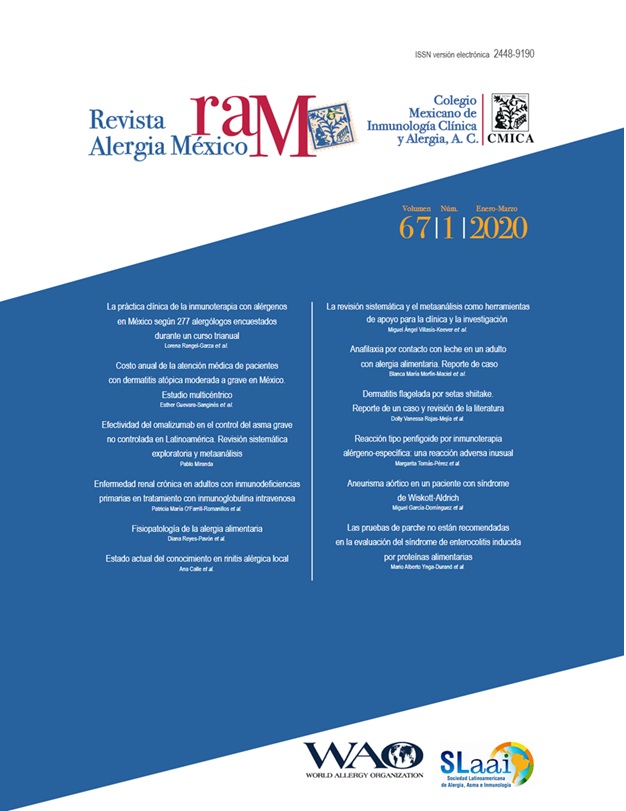Abstract
Background: For the most part, adverse reactions caused by subcutaneous allergen-specific immunotherapy (AIT) are directly induced by the administration of an allergen; there is usually redness and induration at the area of the injection. Other skin lesions are extremely unusual.
Case report: A 40-year-old woman with allergic rhinoconjunctivitis and asthma due to sensitization to grass pollen had received monthly doses of 0.5mL of a subcutaneous polymerized extract of grass pollen with glutaraldehyde and adsorbed in aluminum hydroxide. Five hours after the seventh dose, the patient presented stinging and itching at the area of the injection of the immunotherapy, together with a blistering reaction that appeared later.
Conclusion: Although adverse reactions by allergen-specific immunotherapy are rare and difficult to verify, it is important to perform the necessary analyses to identify the causes or their relation to the symptoms to avoid reactions in the future.
References
Guzmán-Fulgencio M, Caballero R, Lara B, Mena M, Tejera M, Sastre A, et al. Safety of immunotherapy with glutaraldehyde modified allergen extracts in children and adults. Allergol Immunopathol (Madr). 2017;45(2):198-207. DOI: 10.1016/j.aller.2016.08.008
Casanovas M, Martín R, Jiménez C, Caballero R, Fernández-Caldas E. Safety of immunotherapy with therapeutic vaccines containing depigmented and polymerized allergen extracts. Clin Exp Allergy. 2007;37(3):434-440. DOI: 10.1111/j.1365-2222.2007.02667.x
Tabar-Purroy AI, Serrano-Delgado P, Beitia-Mazuecos JM, Núñez-Acevedo B. Tipos de inmunoterapia. En: Dávila-González IJ, Jáuregui-Presa I, Olaguibel-Rivera JM, Zubeldia-Ortuño JM, editores. Tratado de alergología. España: Ergon; 2015.
Radice A, Carli G, Macchia D, Farsi A. Allergic reactions after vaccination: translating guidelines into clinical practice. Eur Ann Allergy Clin Immunol. 2019;51(2):51-61. DOI: 10.23822/EurAnnACI.1764-1489.86
Gordon SC, Bartenstein DW, Tajmir SH, Song JS, Hawryluk EB. Delayed-type hypersensitivity to vaccine aluminum adjuvant causing subcutaneous leg mass and urticaria in a child. Pediatr Dermatol. 2018;35(2):234-236. DOI: 10.1111/pde.13390
Rodríguez-Jiménez B, Muñoz-García E, Veza-Perdomo S, González-Herrada C, Kindelán-Recarte C, Domínguez-Ortega J. Vitiligo induced by specific immunotherapy with grass pollen: The Koebner phenomenon. J Investig Allergol Clin Immunol. 2016;26(5):331-332. DOI: 10.18176/jiaci.0088
Fuertes-de Vega I, Iranzo-Fernández P, Mascaro-Fernández JM. Bullous pemphigoid: Clinical practice guidelines. Actas Dermosifiliogr. 2014;105(4):328-346. DOI: 10.1016/j.ad.2012.10.022
Rosenblatt AE, Stein SL. Cutaneous reactions to vaccinations. Clin Dermatol. 2015;33(3):327-332. DOI: 10.1016/j.clindermatol.2014.12.009
Pichler WJ, Tilch J. The lymphocyte transformation tests in the diagnosis of drug hypersensitivity. Allergy. 2004;59(8):809-820. DOI: 10.1111/j.1398-9995.2004.00547.x

This work is licensed under a Creative Commons Attribution-NonCommercial 4.0 International License.
Copyright (c) 2020 Revista Alergia México

